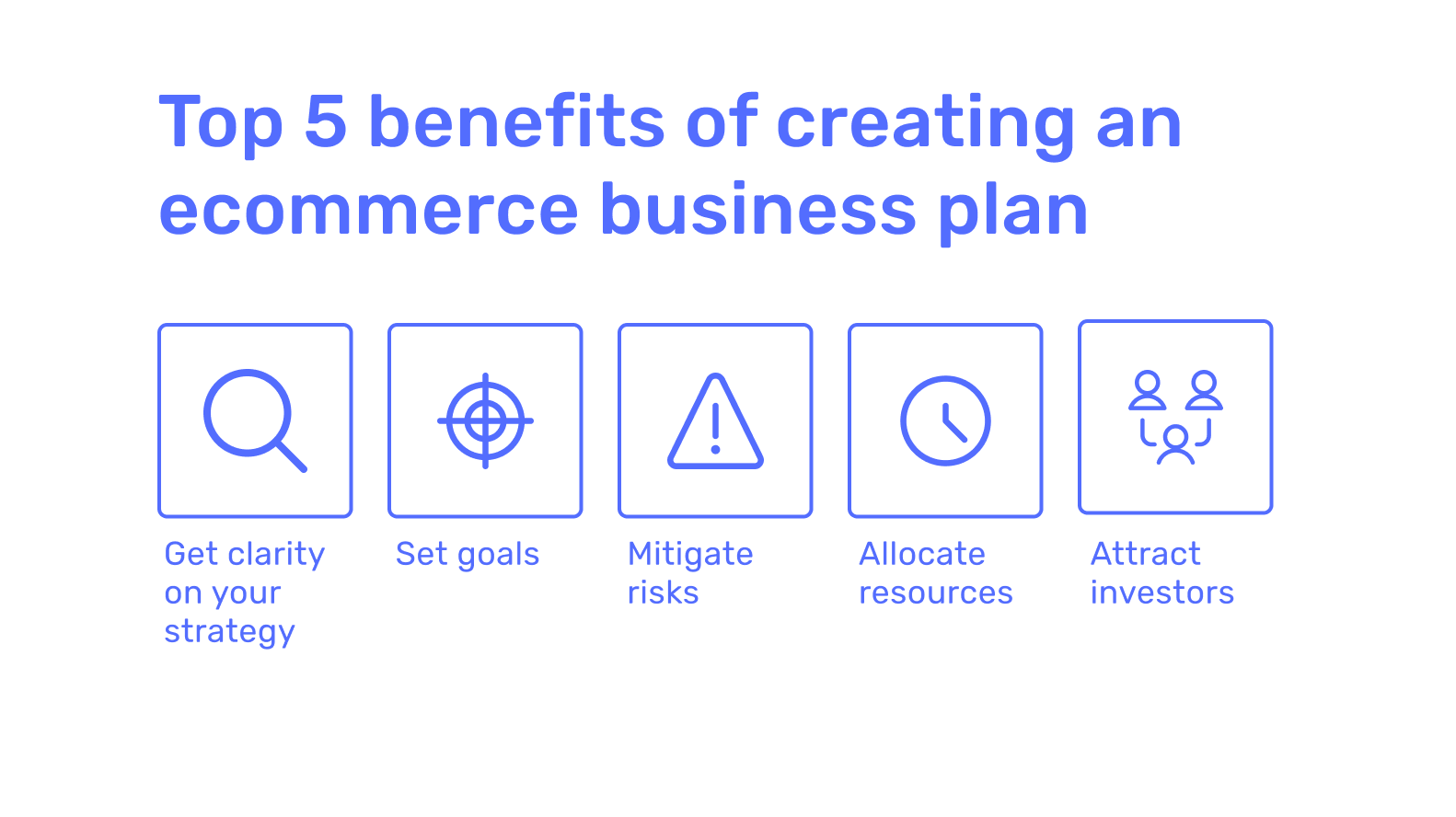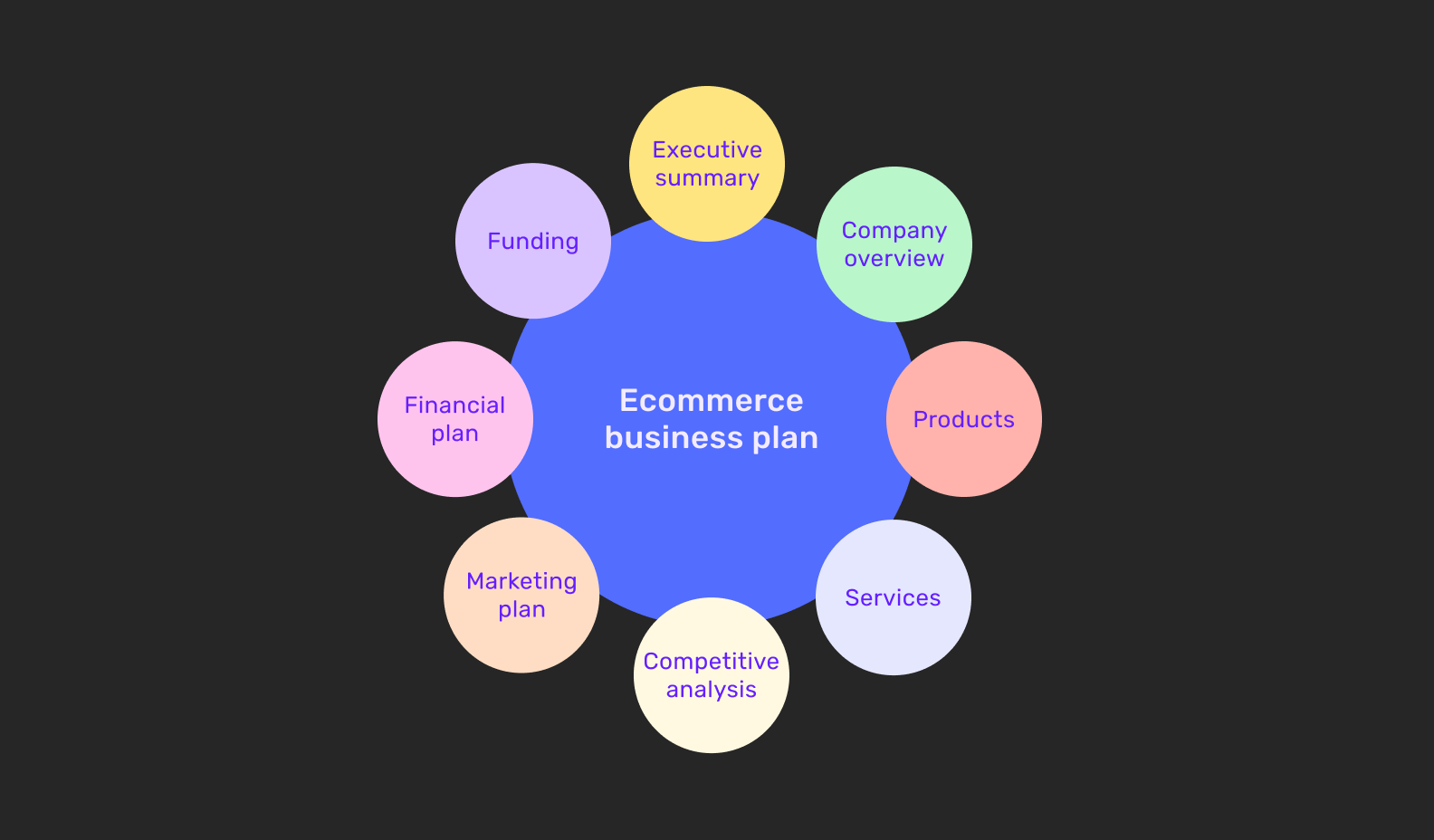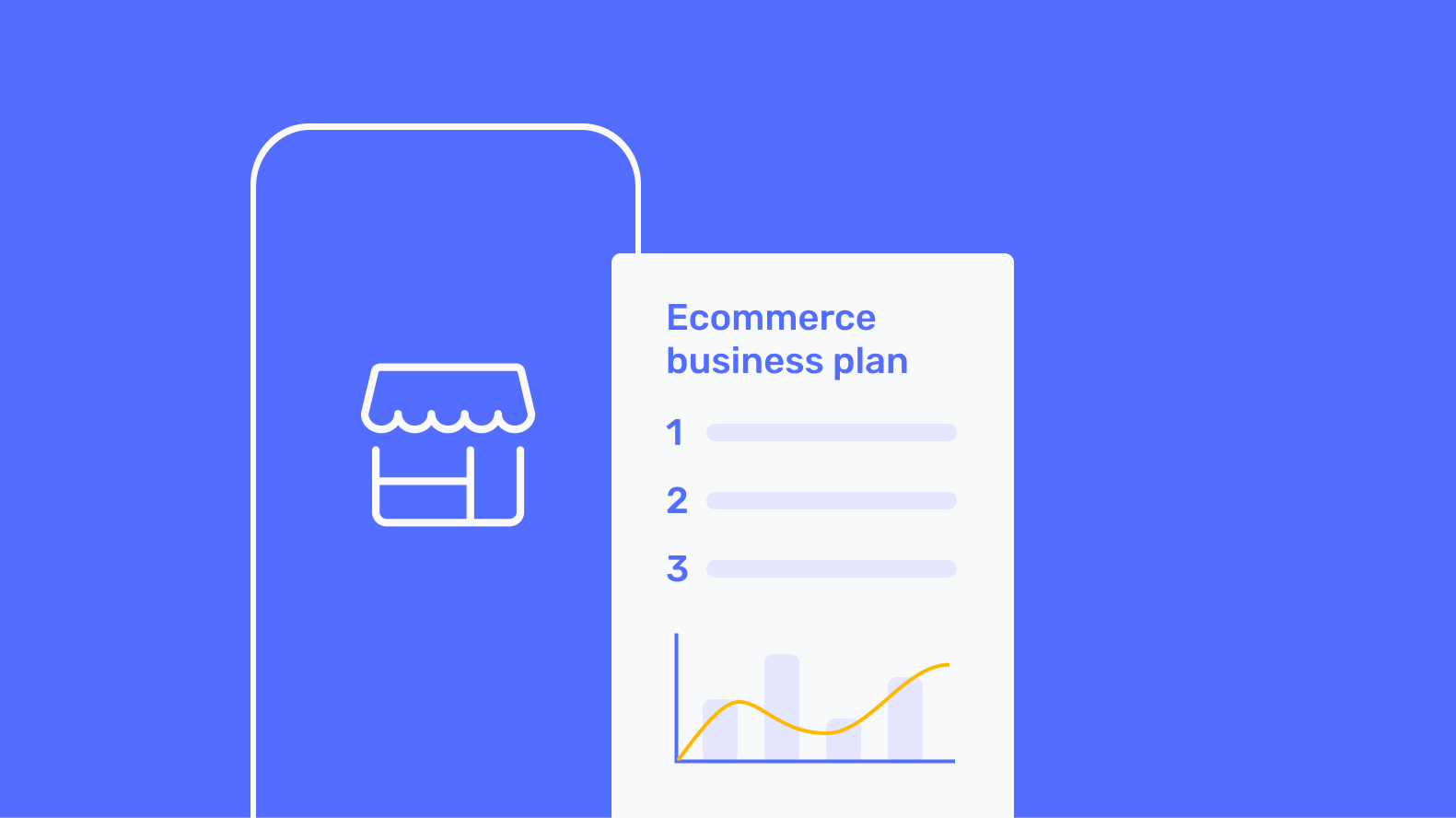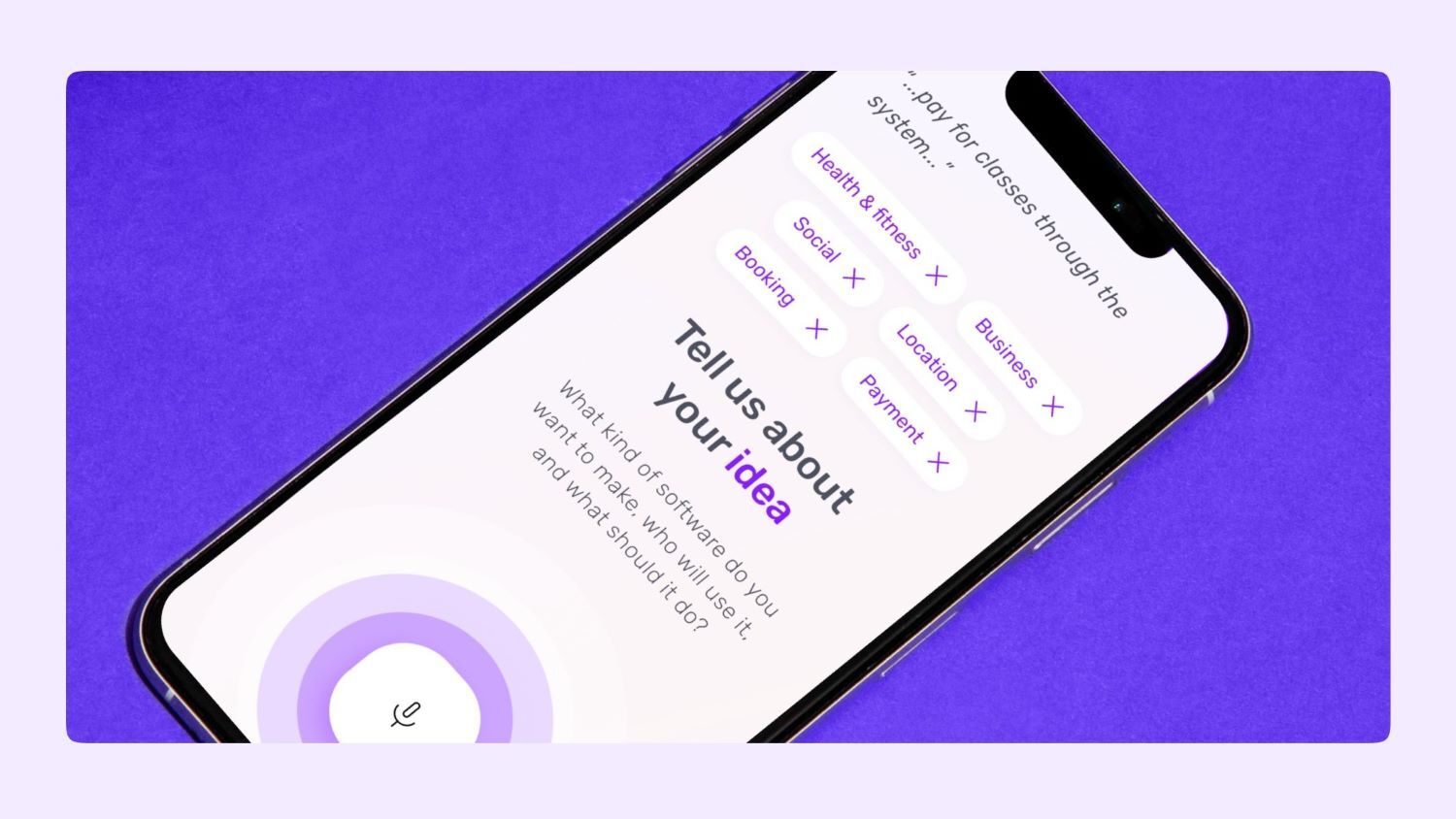By 2026, almost 24% of all retail purchases will take place online.
As these numbers suggest, today is unarguably the best time to start an ecommerce business. However, if you want to get a slice of this $8 trillion pie, you’re going to need to do some preparation first.
In this blog, I’m going to give you a step-by-step guide to creating an ecommerce business plan. This will not only help you set clear goals but also help you attract investor funding.
Let’s get into it 👇
What is an ecommerce business plan?
An ecommerce business plan is a strategic document that outlines your online business’s goals, objectives and operational details. It helps you and your investors understand the business’s direction, competition, marketing strategies and financial requirements.
Simply put, an ecommerce business plan is a structured way to lay out your business idea. It makes it easier to share with investors and people who can help your business succeed. The more details your ecommerce plan has, the better you can accomplish your goals.
Benefits of an ecommerce business plan
Before we dive into the nitty-gritty of creating an ecommerce business plan, let's clarify why it's crucial. A well-constructed ecommerce business plan helps you realise the following benefits:

- Get clarity on your overarching strategy - decide a clear direction of travel for your ecommerce business
- Set goals - monitoring ecommerce business metrics allows you to track your progress and stay focused
- Mitigate risks - by conducting thorough market research and risk analysis, you can identify and address potential pitfalls
- Allocate resources - effectively budget to ensure your online store doesn't run out of steam before reaching the finish line
- Attract investors - if you're seeking funding, a well-crafted ecommerce business plan can be a powerful tool for convincing investors and banks to support your online business
Now, let's journey into creating your comprehensive ecommerce business plan!👇
7 steps to creating the perfect ecommerce business plan

1 - Create an executive summary
The executive summary introduces people to your vision, mission, objectives and key metrics, piquing interest in your business.
Vision and mission
Your vision is the North Star you want your ecommerce business to follow. It's the big picture or the end goal.
Your mission is your compass. It directs your daily efforts towards achieving that vision.
For instance, for your ecommerce store, your vision could be to create an online retail empire that revolutionises the shopping experience.
Your mission could be to provide a wide range of high-quality products and services and deliver them with exceptional customer care.
Business objectives
Goals are the milestones on your journey to success. Make them specific, measurable, achievable, relevant and time-bound (SMART).
For instance, you might aim to generate $100,000 in annual revenue in the first 12 months of your ecommerce business. You could use the SMART framework to achieve this goal like so:
- S - I need to register a 20% average monthly revenue growth to hit my goal
- M - I need to track performance metrics like cost per acquisition, average order value (AOV) and customer lifetime value (CLV). I want to ensure we’re trending in the right direction
- A- I have a deep understanding of the customer base I’m serving and the problems I need to solve for them, meaning my goal is attainable
- R - I need to scale my user base if I want my ecommerce business to be sustainable
- T - I need to split my yearly website visitor goal into quarters to track my progress
Key metrics
These are the measurable data points that will show your business performance. Some examples include customer acquisition cost (CAC), churn rate and user satisfaction scores.
These metrics will be your guide throughout the journey, informing your decisions and strategies.
For your ecommerce business, you'd want to track:
- CAC - aim for $20 or less
- CLV - maintain an average of $100 or more
- Monthly revenue growth - target a 20% month-on-month growth rate
- Churn rate - keep churn below 20% per month
2 - Company overview
This section of your ecommerce business plan describes exactly what your company does. Here, you’re introducing your business to your potential investors and partners, telling them how it is different from your competitors or other ecommerce companies.
You’ll also need to explain what makes your business unique, your business model, ownership and management structure.
This section should include:
Company description
A company description explains what your company does and how it aims to fill the gaps in the current marketplace. Here, you should include the most compelling benefits of your business and how they’ll bring in customers.
Your company description also includes your company’s history, target market and audience, while also describing how you plan to evolve with changing customer preferences.
Business model
A business model outlines whether:
- You’re planning to use a traditional sales model or a subscription model
- You’ll sell directly to customers or source products for other manufacturers
- You’ll operate a business-to-business (B2B) or business-to-customer (B2C) ecommerce store
Unique selling proposition (USP)
This section explains how your business will stand out from the competition and what your plan is to become a leader in the industry. It also answers how your product or service will fulfil the needs of your customers and what problems you’re trying to solve.
Management structure
The ownership and management structure provides background on your business’s leadership and details about the composition of your workforce.
3 - Describe your product and services
Now that you’ve described your business and its goals, it’s time to go deeper into your ecommerce business plan. In this section, you’ll describe the range of products or services your online store will offer.
If you plan to offer a wide range of products, then provide a brief description for each product line. Or if you want to sell a select few items, then provide more details about each product, like the cost of manufacturing and selling price. This ensures that potential investors gain a thorough understanding of your product offerings and business ethos.
Product and service descriptions should also clarify for investors whether you manufacture the products, dropship them or source them from a wholesaler. This section is a good place to tell them how your products are superior to the competition and what advantages they provide to your customers.
Finally, mention the payment gateways, courier services or third-party aggregators you’re partnered with to provide the shopping experience to your customers.
4 - Conduct competitive analysis
Understanding your competitors is essential for any ecommerce business. A thorough competitive analysis helps you:
Identify direct competitors
Identify online stores that are similar to yours, offering comparable services or products. Then analyse their strengths and weaknesses, their market positioning and their user base.
As an ecommerce business, an obvious competitor would be Amazon. After performing a competitor SWOT analysis, you might find the following information:
- Strengths - vast product selection, efficient logistics and a strong brand
- Weaknesses- intense competition, limited personalisation
- Opportunities - expanding into new markets and verticals
- Threats - regulatory challenges, reputation management
Identify indirect competitors
Aside from your direct competitors, alternative solutions may also be competing for your target audience's time and attention.
For your ecommerce store, you need to consider brick-and-mortar stores as part of your competitive analysis. After researching them, you might find the following information:
- Strengths - in-person experience, instant gratification
- Weaknesses - limited product selection, restricted operating hours
- Opportunities - ecommerce integration, enhanced customer service
- Threats - ecommerce competition, evolving consumer behaviour
Uncover competitive advantages
With this information, you can determine what sets your online store apart. It could be a better pricing strategy or a niche focus on a specific user segment. Only by understanding your competitive advantage can you gain clarity about your online business's unique value proposition.
Building on who your competitors might be, you could consider these as your competitive advantages:
- Curated product selection
- Personalised shopping experience
- Superior customer support
- Streamlined mobile shopping
- A loyalty rewards program
5 - Develop a marketing plan
Your marketing plan should outline four main topics:
- Positioning strategy
- Acquisition channels
- Tools and technology
- Goals and evaluation
Positioning strategy
A positioning strategy is a distinct image or perception of a product or service in consumers' minds.
A positioning strategy's goal is to differentiate your product or service from the competition. It aims to create a clear and distinct value proposition for consumers.
To create a positioning strategy, you must:
- Define the personality and characteristics of your brand
- Position your products based on the perceived value they offer in relation to their price
- Develop messaging that communicates your unique value proposition
- Ensure consistency across all touchpoints, including messaging, colours, logo etc.
An effective positioning strategy allows you to occupy a distinct and favourable place in the minds of your consumers. This makes it more memorable and appealing.
For example, footwear brand Crocs was once considered unappealing. But over a period of time, they transformed their brand image by changing their positioning.
Tapping into the rise of ugly-chic fashion trends, Crocs decided to collaborate with luxury brands and influencers in order to reach new audiences.
Today, Crocs has become one of the hottest fashion brands in the world, selling over 850 million pairs of shoes.
Marketing channels
In this section, you highlight the marketing channels you’ll use to acquire customers. These are the specific methods that your business will use to reach out to and engage with potential customers.
- Paid advertising - use Google Ads for targeted keyword advertising and product listings; alternatively, you can invest in paid advertising on social media platforms
- Content marketing - develop content that addresses the challenges and needs of your target audience; you should also create informative content about your products and industry trends
- Social media marketing - choose social media platforms where your target audience is active
- Email marketing - create personalised email campaigns for each segment of your target audience
- Influencer marketing- find influencers whose audience matches your target market, collaborating with them to promote your products
- Events and trade show marketing - network and build brand awareness at industry-specific events, trade shows and conferences
Tools and technology
Here, you’ll shed some light on the tech stack you’re going to use to execute your marketing campaigns.
Many different tools and technologies can help you execute your marketing campaigns. Some of the common tools include:
- Marketing automation software - automate repetitive tasks, like scheduling social media posts and managing email marketing
- Customer relationship management (CRM) software - manage and analyse data to create personalised customer experiences; you can also track customer’s history of interactions with your brand
- Social media management tools - they help you plan, schedule and analyse social media performance with one platform
Goals and evaluation
These are the metrics you typically use to evaluate your marketing efforts. Here, you also need to define the goals you want to achieve through marketing.
Some of the key metrics that you need to consider are:
- Revenue and sales - use metrics like average order value, total revenue or conversion rate
- Traffic and engagement - look into page views, website traffic or social media followers
- Brand awareness and perception - use metrics like net promoter score (NPS), brand recognition rate or customer satisfaction
- Customer acquisition and retention - for retention look into churn rate, customer lifetime value (CLV) or customer satisfaction
6 - Plan your finances
The clarity of your financial data, including your costs, budgets and revenue projections, is a dealbreaker when it comes to securing investor funding. And while you may need to amend them over time, presenting a clear picture is crucial.
Here’s how you can start to do that:
Online store development costs
Estimate the cost of labour, technology, software licences, equipment and other resources. Be detailed in your estimates to avoid unexpected financial surprises.
Operating expenses
Forecast your ongoing expenses, such as server hosting, marketing, customer support, maintenance and any other operational costs. A well-prepared budget will help you manage your resources effectively.
Revenue projections
Predict your revenue based on user growth and your chosen business model. Don’t be too outlandish with your estimates and consider multiple scenarios, including best-case and worst-case, to understand the range of potential outcomes.
Break-even analysis
Determine when your online store will start generating enough revenue to cover all its costs. The break-even point is a crucial milestone that indicates the financial sustainability of your ecommerce business.
7 - Use the ecommerce business plan to secure funding
Once you have your ecommerce business plan, it’s time to use it as a tool to get you the funds you need to develop your online store.
Choosing the right funding source depends on your online store's development stage, funding needs, and the trade-offs you're willing to make in terms of control and equity.
Here are the various avenues you can follow to raise capital for your ecommerce business:
Personal savings
If you have personal savings, this can be an initial source of funding for your ecommerce business. Using your own funds can give you more control and flexibility.
Bootstrapping
This involves building and growing your ecommerce business without external funding. Bootstrapping may require you to invest your own money, work with a small team and focus on organic growth.
Angel investors
Angel investors are individuals who provide capital to early-stage startups in exchange for equity in the company. Finding the right angel investor can bring not only funding but also valuable expertise and connections.
Venture capital
Venture capital firms invest in startups with high growth potential. They typically provide larger amounts of funding in exchange for equity. Venture capital can fuel rapid expansion, but it also involves giving up a portion of ownership.
Crowdfunding
Crowdfunding platforms, such as Kickstarter or Indiegogo, allow you to raise funds from a large number of people. They believe in your ecommerce business idea and thus invest in you. In return, backers may receive rewards or early access to your online store.
Bank loans
Traditional bank loans can provide capital for your ecommerce business, but they require repayment with interest. Ensure you have a solid business plan and financial projections to secure a loan.
Grants and competitions
Some governments, organisations and startup competitions offer grants or prizes for innovative business ideas. These opportunities can provide non-dilutive funding.
Things to do once your business plan is complete
1- Create your online store
Now that you’ve used your ecommerce business plan to secure funding, it’s time to actually start your ecommerce store. Here are the key steps you need to follow:
Find the right development team
Depending on your ecommerce store’s complexity, you might need developers, designers, quality assurance experts, project managers and more. Choose individuals or teams with the skills and expertise to execute your vision.
Choose the platform
Select the right platforms (e.g., website, app or web app) and technologies that align with your store's objectives. Different platforms offer different advantages and cater to distinct user bases, so choose wisely. Additionally, consider the technology stack and tools required for your ecommerce store development.
Select features and functionalities
Define the core features of your online store. For instance, you might need:
- Secure payment processing
- User-friendly product search and filters
- Product recommendations
- Customer reviews and ratings
- Wish lists and shopping carts
- Order tracking and customer support
- User profiles and loyalty program integration
Set development timeline
Set milestones and deadlines for your ecommerce store's development phases. A well-structured timeline helps you track progress, manage resources and launch your store on schedule. Be realistic and account for unexpected delays that can occur during development.
2 - Perform an internal SWOT analysis
To ensure the long-term success of your online store, you need to update your business plans as well as your store’s features and functionalities.
Here, a SWOT analysis can help. This is a simple yet powerful strategic planning tool, helping you evaluate your store’s Strengths, Weaknesses, Opportunities and Threats.
This analysis helps you gain a better understanding of your business’s current position in the market. It also helps you make informed decisions about its future development and capitalise on market developments.
Strengths
The first step to conducting a SWOT analysis for your ecommerce business is to identify its current strengths. This involves taking an honest and comprehensive look at what your store excels at in its current state.
Weaknesses
After identifying your ecommerce business’s strengths, it’s time to acknowledge its weaknesses.
This involves pinpointing areas where your online store needs improvement, allowing you to enhance the overall user experience, usability and value propositions.
Opportunities
Opportunities refer to the external factors and circumstances that you can leverage to your online store’s advantage. This section focuses on recent trends and favourable conditions so your ecommerce business can gain a competitive edge and expand its user base.
Threats
Threats have a tendency to lurk in the corner and haunt. Don’t fear them, get them in the front and tackle them individually. Threats can stem from external risks like market risks, financial risks, legal and compliance risks that we need to account for and vary.
Conclusion
By now, you have all the information you need to create a killer ecommerce business plan and a good idea of how you can use it to secure funding.
It’s important to remember, though, that you can’t just set and forget the work you do in this exercise. Instead, you need to continually evolve your plans to meet emerging customer needs. You also should capitalise on any opportunities the market presents.
If you want more ecommerce inspiration, hit the banner below 👇
Want to build your online store?
Book a demoSpeak with one of our product experts today.
By proceeding you agree to Builder.ai’s privacy policy and terms and conditions

Ananth Ramanathan runs Studio Store business at Builder.ai with a mission of digitising a 1M+ micro SMEs in the next 5 years. He oversees the commercial, product, and customer success functions to rapidly scale Studio Store globally. Ananth's an experienced tech business operator, a failed entrepreneur, and an active angel investor.












 Facebook
Facebook X
X LinkedIn
LinkedIn YouTube
YouTube Instagram
Instagram RSS
RSS


